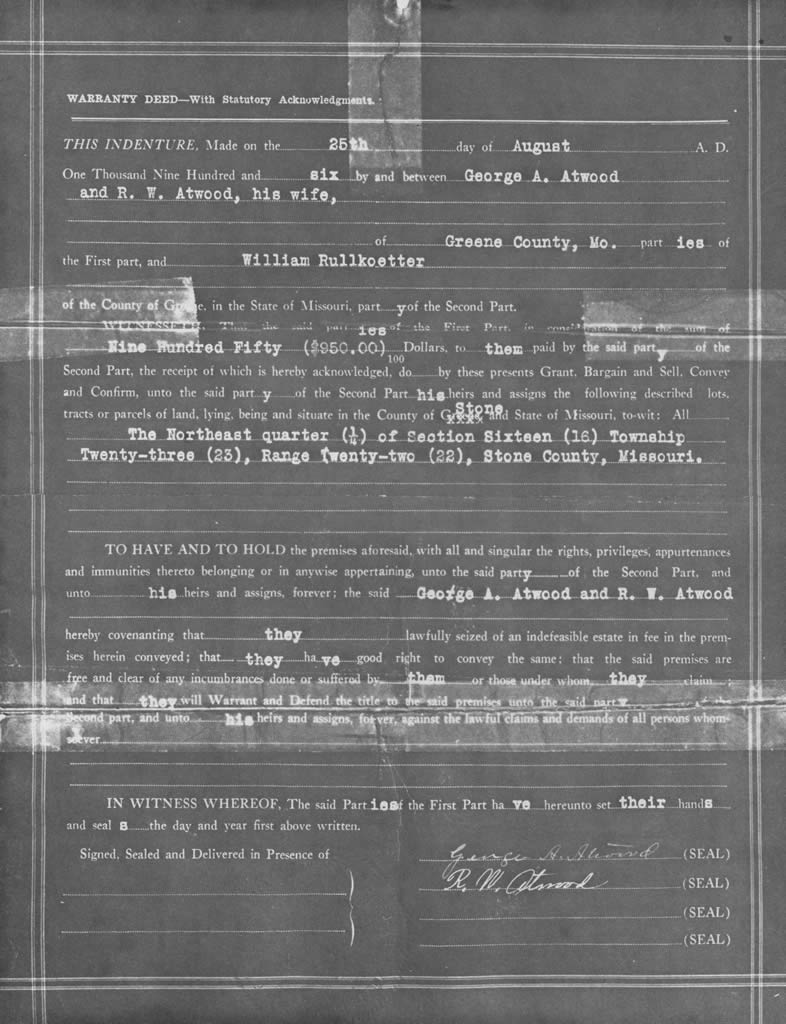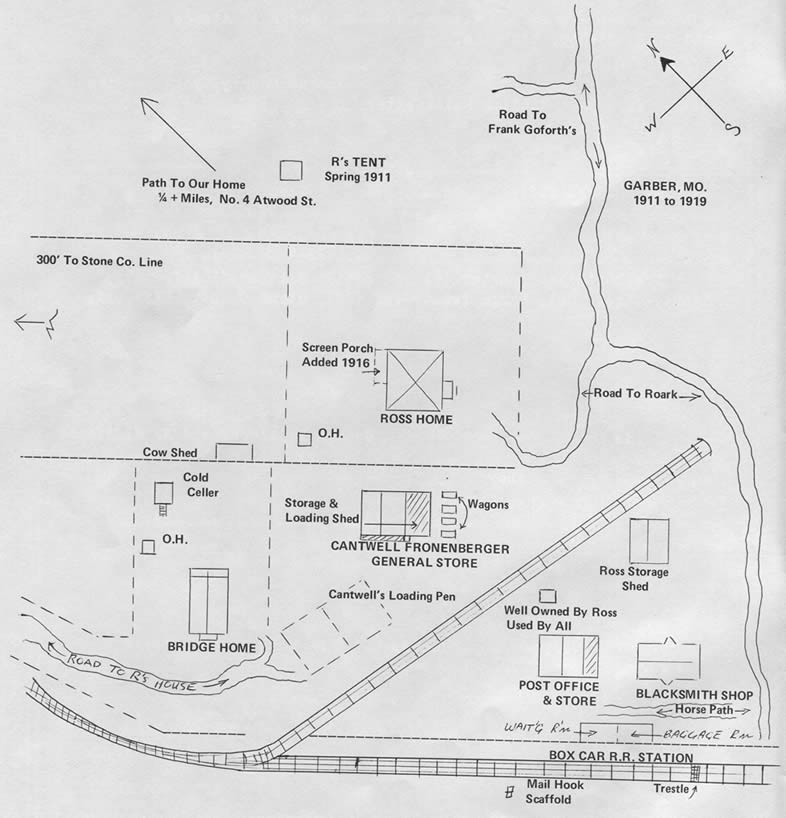Volume 4, Number 6 - Winter 1971
A Quick Sketch of Garber As It Was In My Time
John W. Rulketter
I was blessed with a photographic mind so within a few feet or so this is an accurate map. One O. H. I am not real sure of.
The township of Garber originally called for 26 acres. They never used more than four or five. During the years 1911 to 1918 they had an urban population of 4 people; the Bridges and the Rosses. When I was there it was, of course, 5, and if you count J. K’s dog, Ring, there were 6.
The Bridge home had evidently been built before the turn of the century. It was part log and of the shot-gun design used at that time. Bridge was the blacksmith. He also cut hair..with a bowl..what else?
Behind the Bridge house was the cold cellar used by all. In hot weather you were smart to carry a hooligan stick to chase the snakes from the steps leading down to the cellar. Butter stayed just above the liquid form. Ice was a commodity we did not have.
The big barn, like store with the false front, like you see in western movies was next door. Across the facade in large letters was CANTWELL and FRONENBUGER. It was said that Bob Cantwell owned the business and Bill F., his brother-in-law, ran it. Anyway, Bob never seemed interested in it, nor did I ever see him do any work around the store.
The loading pen was put up when Bob had one or more carloads of cattle to go out. He was real nice about letting others, with a few head of cattle, use the pen and ship when he did. Bob and I talked about the large shipments he used to make, when I last saw him in 1940.
Across the railroad spur was J. K.’s post office which also sold some groceries, patent medicines, and tobacco. The west side was used as the post office and his office. I can clearly see the pigeon holes for the mail and the small window where you passed the mail into the hands of the recipient.
Only on rare occasions did J. K. Ross allow me to perform this transaction even though it would have been hard to make a mistake as there was not that much mail. He was very conscientious about his job. I guess he considered this an official governement transaction.
There, too, sat the potbellied stove and his desk. The desk is now shown at the Shepherd of the Hills Farm. I would recognize it anywhere.
A railroad car served as the station and the mail hook scaffold stood across the tracks. Garber was a flag stop and not many trains stopped. When one did stop it was great fun to anticipate who would get off and what baggage would be unloaded.
Then there was the blacksmith shop, a most fascinating place, particularly during the logging years. Then Bridge had almost more than he could handle.
The well, J. K. owned. This was a drilled well, only 106 feet deep, but there was only one year when he had to ration the water.
The tar-paper storage building was used for grain, seed, and a multitude of things which needed to be stored in a dry place.
To the north and west was J. K.’s and Mrs. Ross’s home. I always addressed "Aunt Mollie" as Mrs. Ross, even though our realtionship was very close, almost a mother and son. She was such a lady that you wouldn’t think of doing otherwise. Old Matt was different. He liked the informality of "J.K." and told me so.
For about two months our family lived in a tent just north of the Rosses while our house was being built. Although there were not even wagon tracks in front of our tent it was the only abode with a street address, No. 4 Atwood St.
This came about when my Mother who was spending a few days with Mrs. Louis Cahill in Branson, sent us a card. Just for fun she addressed it to that address, Garber, Mo. This card was passed around to forty or so people and everyone got a laugh out of it. In one paragraph (which probably should be many) is a physical picture of Garber. (I still have the card.)
Roads, as we think of them today, did not exist around Garber. Roads just happened. A wagon trail led up to our place because ties were cut there and on adjacent property. Another road went north to Frank Goforth’s. The main road was a stair step trail leading down the hill and under the railroad.
[1]
At the foot was the main branch of the Roark and Gus Vinning’s home.
There were three Vinning families and although Lester reminded me of their names last fall, I forgot again.
About three-fourth’s mile west was and still is Bob Cantwell’s fine home. East by southeast you crossed a gully, passed through a butternut grove, forded a large branch of the Roark, and turned north under the steel trestle. This brought you to the William Walden place, later the Drum place.
If you continued east by southeast (from the Roark Branch crossing) there was the Howard Cox and Bill Fronenburger homes. All that remains there now is the old log barn. On down the road and across the Roark to the southside was Newt Cox’s home. By turning n.w. and swinging back to the n.e. over the R.R. tracks and on up the hill from Howard Cox’s was the school house.
How well I remember every foot of the way both summer and winter. Just about three miles from our house. Now mama drives the children two blocks but I would not trade, not even with long odds.
Calvin Jones and his boys lived just beyond the school. Willard Jones still lives on their property. Two families of Davis lived in the area. One family north of the Roark, just west of Newt Cox, and the other in our house for some time.
One of the occupants of our house, for which I am most grateful was Tom Walden. His first child, Velma Walden Bass, was born there. I remember the occasion well. She is a real favorite of ours.
Other names that ring a bell in my mind are the Basses and the Lewallens. Then of course, were the transients and those who came into the area on logging and R. R. jobs.
Some may ask what purpose did Garber serve other than being the most western town in Taney County. Well! It was a distribution center. This is hard to believe until you think of the roads of the Ozarks in those days. You couldn’t travel far, even five or ten miles by wagon. I can still see the wagons drawn up to the loading shed on Saturday at the C and F Store.
We all bought supplies by the 10-25-50-100 and 200 lbs., feed bags in those days. This made fewer trips and also gave us cloth for some of our clothing. Even gunny sacks well ‘biled’ (boiled) once or twice weren’t too bad. By the way, have you seen the beautiful quilt made by Margie Walden out of flour and sugar sacks?
Most of the counties around the White River were free range. The cattle business was fair, although spotty. Some hogs, and though poor, a little fruit, hay, and corn.
For a little while we did a real business in R. R. ties. Good solid oak ties brought between 18 and 25 cents. The hewers were paid 11 or 12 cents per tie. Many good oaks are no longer on our property. Sold for a fraction of a cent a board foot.
For a few years logs were hauled from as far as ten miles away to our siding at Garber. Some came from the area south of where highway 76 now is. It was as easy to transport them to Garber as to Branson. The roads in that area were very bad. The haulers made their own new roads back to Garber. I know the route of one of these roads but do not suggest that anyone tries to drive it now. Even if they did not get lost their car wouldn’t make it.
We had a good siding which Father, and I presume others, were instrumental in having put in at the time the railroad was built. For three summers this was used for the work cars of the bridge repair crews. All the fills you see now were wooden trestles and required a great deal of repairs. This added from seven to twelve more customers for the stores.
Then there were the tourists. We had about thirty or forty a season. Some just stood around and took pictures, mainly of Old Matt, and caught the afternoon train. Others wanted to go over to the cave or to see Old Matt’s cabin, etc. Most of the tourists, (the smart ones) went to Notch (Reed City to Notch) in the mail carrier’s rig or hired another rig from Reed City.
Some one might be interested in our law enforcement. We really didn’t have any. Once when there was a killing, the sheriff from the county seat showed up two days later. He asked a few questions and after about an hour was on his way home. The older folks said he sure was in a hurry to get back to the bright lights and the big city of Forsyth.
The Warranty Deed shows that my father, William Rullkoetter, of Greene County, Missouri, on the 25th day of August 1906 bought from George A. Atwood and R. W. Atwood, his wife, for Nine Hundred and Fifty ($950.00). The Northeast quarter (‘/4) of section Sixteen (16) Township Twenty-three (23) Range Twenty-two (22), Stone County, Missouri.
This was before the railroad came through. They were working on it, but the
[2]

[3]
first run was a year later. I can so well remember Dad's description of the horseback ride from Crane and back the next day. I do not know where they stayed the night. Father did not meet Old Matt- J. K. Ross - For I believe the Rosses did not move to Garber until early 1907. This, although J.K. had already received the appointment as postmaster and the job of station master

[4]
This volume: Next Article | Table of Contents | Other Issues
Other Volumes | Keyword Search | White River Valley Quarterly Home | Local History Home
Copyright © White River Valley Historical Quarterly

